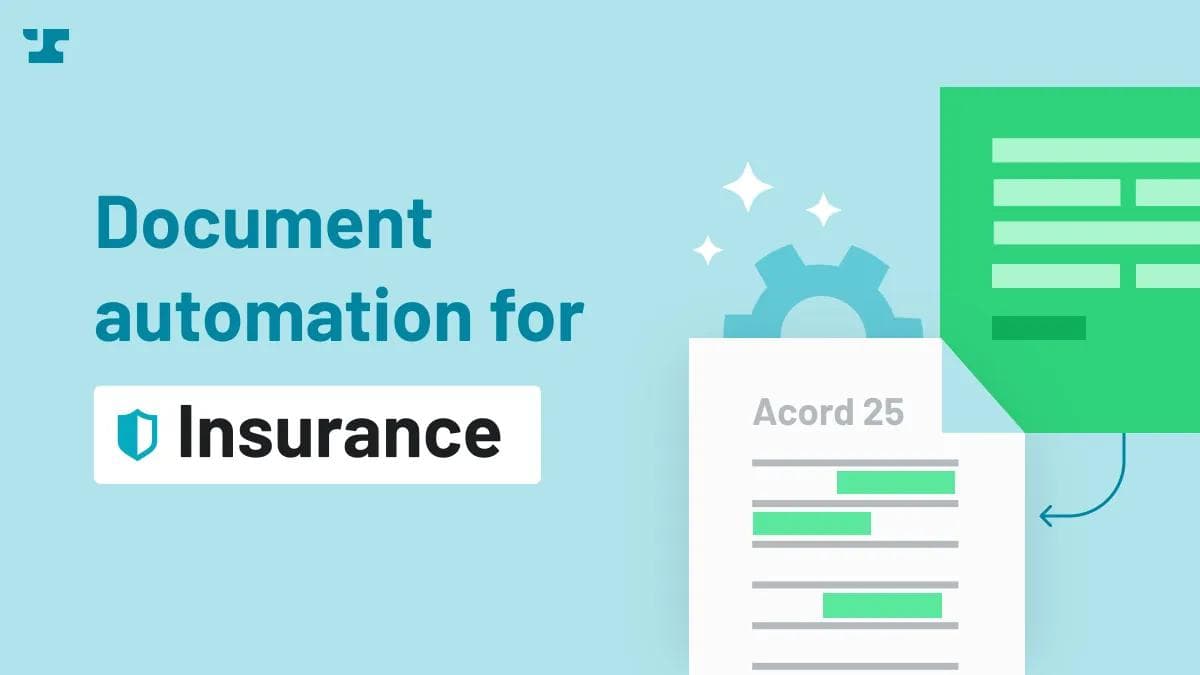For decades, the insurance industry has been characterized by archaic rules and heaps of paperwork that have effectively limited new players from entering the arena. Seeing an opportunity to create efficiency through technology, a new generation of ‘insurtech’ companies has leveraged automation to disrupt this legacy industry. Insurtech companies strive to provide a modern, digital experience for their customers, but have found automating paperwork to be an unexpectedly challenging problem to solve. If implemented correctly, the right no-code solution can offer a way out.
Why document automation for insurance is challenging
Standard insurance forms are long and repetitive.
Many standard insurance forms run as long as 10-20 pages, so any effort at automation requires mapping data to dozens or even hundreds of fields. Anyone familiar with insurance paperwork will know that many fields are repetitive, requiring the same information in different places on the form. A name or address, for example, might appear on every page. To be efficient, any automation tool will need to be able to map a single piece of information to multiple places on a form or set of forms - something that is uncommon in most no-code webform applications.
Rules for completing insurance forms are complicated
The word “Byzantine” is often used to describe insurance paperwork, and for good reason. Most forms require logic beyond your simple IFTTT to complete accurately. For example, common business insurance forms require pages to repeat with specific numbering if there is more than one physical location. In another common case, any information that doesn’t fit on the original form must overflow onto a different form entirely. Adding to the complexity, the form instructions are often ambiguous or unclear, making it nearly impossible to encode the logic into an application without being intimately familiar with industry standards and expectations.
Insurance document automation is easier than you think
Leading insurtech companies like Vouch, Agentsync, and Newfront have successfully used no-code tools to significantly improve their processing time and capacity. Here is what we have learned from talking to and providing solutions for them:
1. Identify inefficient processes.
This might seem obvious, but it’s crucial to finding the right solution. Take the time to comprehensively evaluate processes that can be automated. Are you spending hours each week emailing forms and PDFs to customers? Are you repetitively entering data into multiple platforms? You’re not alone. This inefficiency can be found in most insurtech companies. Vouch, a digital insurance provider that offers proprietary coverage for startups, came to Anvil after identifying many of these same issues. They found themselves looking for a more streamlined solution to turn dozens of standardized forms that the industry uses into branded webforms.
2. Invest in flexible automation solutions.
Once you’ve identified areas that can benefit from automation, you’ll want to invest in solutions that are easy to implement for your operations team and flexible enough to handle all the edge cases and complexities of insurance paperwork. One common pitfall for insurtech companies is starting with no-code technology that is highly accessible, but ultimately not powerful enough to handle anything other than the most straightforward business logic. No-code tools like Anvil Workflows that are built for automating enterprise-grade paperwork allow anyone, regardless of technical proficiency, to make process changes that scale.
3. Automate the most common documents first.
So, you’ve identified inefficiencies and found a flexible solution that can automate your PDFs and forms. Now, you can select which forms to automate first. When Vouch implemented Anvil Workflows, they started by automating 25 of their most common and time-consuming forms. Having a single platform that manages all incoming and outgoing data has already increased their capacity to take on new customers by 33%. And they’re just getting started.
Getting started with document automation for insurance
Manual paperwork has long been a bottleneck to scaling in the insurance industry, but with the right strategies and tools, overcoming this challenge is more achievable. If you're ready to modernize your document operations, the first step is to identify the most inefficient processes in your document workflow. From there, investing in a flexible, no-code automation solution like Anvil can help you tackle the complexities of insurance paperwork. By starting with the most common documents, you can quickly see improvements in processing time and capacity, just as leading insurtech companies have. And with our new Document AI features, you can get from PDF to complete document automation faster than ever.
To learn more about how Anvil’s solutions can improve your operations and help you get started with insurance document automation, sign up today or request a demo. We're here to help you take the next step.

